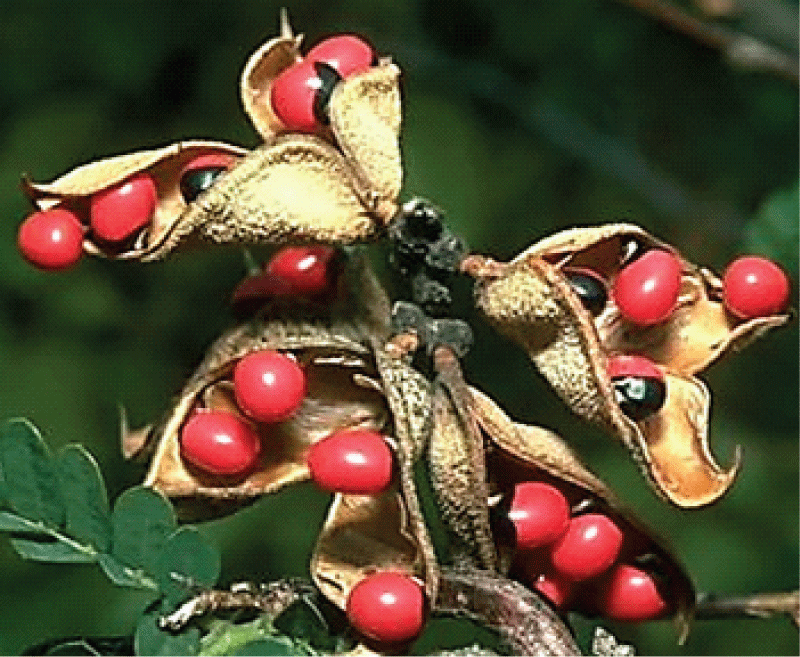A Mini Review on Different Methods for Detoxifying Abrus precatorius
Introduction
Abrus precatorius, commonly known as the rosary pea or jequirity bean, is a climbing plant widely distributed in tropical and subtropical regions. Its seeds, characterized by their bright red and black appearance, contain abrin—a highly toxic ribosome-inactivating protein. While abrin’s presence poses significant health risks, the plant has been used for centuries in traditional medicine for its antimicrobial, antioxidant, anti-inflammatory, and neuroprotective properties. To safely utilize the therapeutic potential of Abrus precatorius, effective detoxification methods are crucial.
This blog explores various detoxification media and techniques for reducing the toxicity of Abrus precatorius seeds. Drawing from the referenced study and traditional Ayurvedic practices, it highlights innovative approaches to detoxify the seeds while preserving their medicinal properties.
The Need for Detoxification
Abrus precatorius seeds are among the deadliest natural toxins, with abrin causing severe cellular damage even in minute quantities. Chewing or ingesting the seeds can lead to gastrointestinal distress, multisystem organ failure, and death. Despite these dangers, the seeds’ medicinal benefits make them a valuable resource in pharmaceuticals, traditional medicine, and agriculture. Detoxification methods aim to reduce or neutralize abrin while retaining the seeds’ bioactive components for safe usage.
Traditional and Modern Detoxification Techniques
Shodhana: The Ayurvedic Approach
- Description: Shodhana, meaning “purification,” is an Ayurvedic process used to detoxify toxic substances.
- Methodology: The seeds are treated using media such as cow’s milk, urine, lemon juice, and fermented rice water. Heating and soaking are common techniques to denature the toxic proteins.
- Effectiveness: Shodhana is effective in breaking down abrin’s structure, rendering it less toxic while preserving the seeds’ therapeutic properties.
Physical Removal of the Seed Coat
- Description: This straightforward method involves scraping or sanding the outer layer of the seeds, where much of the toxin is concentrated.
- Limitations: While effective in reducing surface toxins, this method may leave residual toxicity due to abrin’s penetration beyond the seed coat.
Leaching in Water or Solvents
- Description: Soaking the seeds in water or saline solutions helps extract toxins.
- Traditional Media: Fermented rice water (kanji) and lemon juice are frequently used due to their acidic and enzymatic properties.
- Challenges: Abrin’s water-insoluble nature limits the efficacy of leaching alone, requiring complementary treatments.
Thermal Detoxification
- Description: Heating the seeds in media like cow’s milk or ghee helps denature abrin and other toxic proteins.
- Mechanism: High temperatures destabilize the disulfide bonds between abrin’s polypeptide chains, neutralizing its toxicity.
- Applications: Milk proteins and fatty acids form complexes with the toxins, further enhancing detoxification.
Chemical Treatments
- Description: Using chemical agents like sodium chloride (NaCl) to detoxify the seeds is a modern approach.
- Mechanism: The high ionic concentration in saline solutions breaks disulfide bonds, rendering abrin inactive.
- Effectiveness: This method has shown promise but requires careful calibration to avoid damaging the seeds’ medicinal components.
Biotechnological Advancements
- Description: Genetic engineering offers potential for producing non-toxic Abrus precatorius variants.
- Applications: Scientists are exploring ways to suppress abrin production or modify its structure to make it harmless.
- Current Status: While promising, this approach is still in experimental stages and faces ethical and ecological concerns.
Applications of Detoxified Seeds
Traditional Medicine
- Detoxified Abrus precatorius seeds are used to treat ailments such as diarrhea, inflammation, and skin diseases.
- Ayurvedic and herbal remedies leverage the seeds’ anti-inflammatory, antioxidant, and antimicrobial properties.
Pharmaceuticals
- Detoxified seeds are a source of bioactive compounds for drug development.
- Potential applications include treatments for neurological disorders, diabetes, and immune modulation.
Agriculture
- In agro-industrial contexts, detoxified seeds serve as natural pesticides due to their residual antimicrobial properties.
Challenges in Detoxification
Despite advancements, detoxifying Abrus precatorius seeds presents several challenges:
- Incomplete Detoxification: Residual toxins may persist, posing risks if detoxification is not thorough.
- Nutrient Loss: Overprocessing can degrade bioactive components, reducing the seeds’ medicinal value.
- Standardization Issues: Variability in traditional practices complicates the development of standardized detoxification protocols.
Future Directions
Enhanced Detoxification Techniques
- Combining traditional methods with modern technologies like nanotechnology and biochemistry can improve efficacy.
- Innovations such as enzyme-based detoxification may offer precise and efficient solutions.
Standardized Protocols
- Developing standardized methods for detoxifying Abrus precatorius seeds is essential to ensure safety and consistency in medicinal applications.
Research on Alternative Media
- Exploring additional detoxifying agents, including plant-based solvents and microbial enzymes, could open new avenues for safer and more effective detoxification.
Genetic Engineering
- Advancing biotechnological methods to create non-toxic Abrus precatorius variants could revolutionize its applications while addressing safety concerns.
Conclusion
Abrus precatorius is both a deadly toxin and a valuable medicinal resource, making its detoxification a critical area of study. Traditional methods like Shodhana, along with modern advancements, provide effective means of reducing the toxicity of its seeds. However, challenges such as incomplete detoxification and nutrient loss underscore the need for further research and innovation. By combining traditional knowledge with scientific advancements, we can unlock the full potential of Abrus precatorius while ensuring safety and sustainability.
Tags:
#AbrusPrecatorius #Detoxification #TraditionalMedicine #Shodhana #Toxicology #Phytochemistry #Ayurveda #Biotechnology #HerbalRemedies #PharmaceuticalResearch

Seeds of Abrus precatorius.
